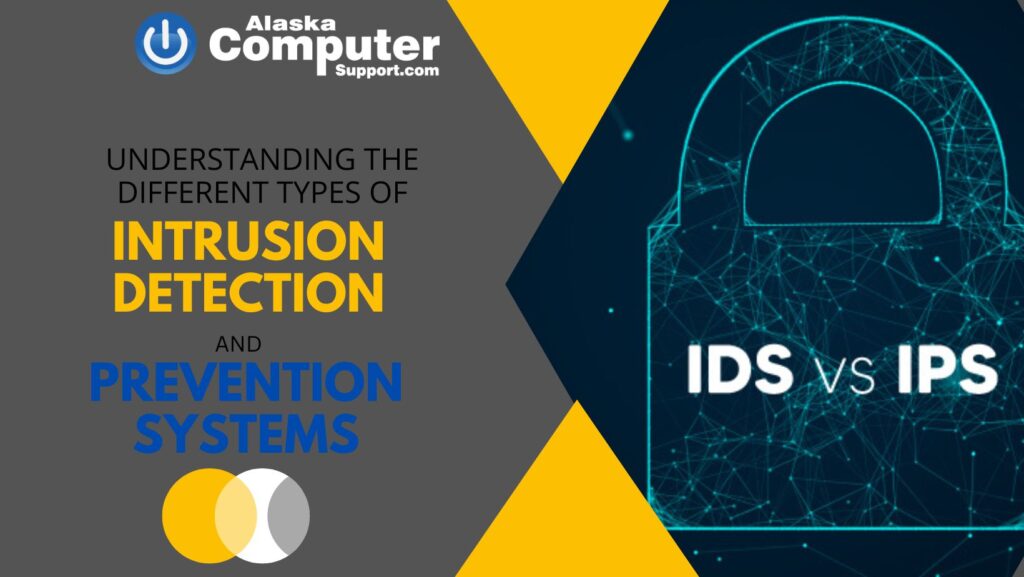“Understanding the Different Types of Intrusion Detection and Prevention Systems

In today’s interconnected world, cyber threats have become increasingly sophisticated and prevalent. To safeguard sensitive information and prevent unauthorized access, organizations rely on intrusion detection and prevention systems (IDS/IPS). These robust security measures serve as the first line of defense against malicious activities. In this blog post, we will delve into the different types of IDS/IPS and explore their functionalities, strengths, and weaknesses. By understanding these systems, you can make informed decisions to fortify your network and protect your valuable assets.
Types of Intrusion Detection Systems (IDS):
- Network-based IDS: A network-based IDS focuses on monitoring network traffic and identifying potential security breaches. It analyzes packets of data flowing through the network to detect anomalies or suspicious patterns. By comparing the network activity against predefined signatures or behavioral models, it can alert administrators about potential intrusions. The key advantage of a network-based IDS is its ability to provide real-time monitoring and protection at the network level. However, it may face challenges in detecting advanced threats that leverage encrypted communications.
- Host-based IDS: Unlike a network-based IDS, a host-based IDS operates at the individual host or endpoint level. It monitors activities and events occurring within an operating system, including file modifications, system calls, and log entries. By examining these host-level events, it can identify any suspicious behavior or unauthorized access attempts. Host-based IDS offers greater visibility into specific systems and can detect attacks that bypass network-based defenses. However, it can be resource-intensive and may impact system performance if not properly configured.
- Signature-based IDS: Signature-based IDS relies on a database of known attack signatures to identify malicious activities. It compares network traffic or system events against a collection of predefined patterns or signatures associated with known threats. When a match is found, it triggers an alert or takes predefined actions. Signature-based IDS is effective in detecting known attacks and provides a high level of accuracy. However, it may struggle with detecting new or unknown threats that lack predefined signatures.
- Anomaly-based IDS: An anomaly-based IDS focuses on identifying deviations from normal network or system behavior. It establishes a baseline of normal activities and alerts administrators when deviations exceed predefined thresholds. Anomaly-based IDS is capable of detecting previously unseen attacks and zero-day vulnerabilities. However, it may produce false positives and require extensive configuration and tuning to avoid overwhelming administrators with alerts.
- Behavior-based IDS: Behavior-based IDS monitors and analyzes patterns of behavior exhibited by users, systems, or applications. It establishes profiles of typical behavior and triggers alerts when deviations occur. By assessing behavioral anomalies, this type of IDS can detect insider threats, zero-day attacks, and advanced persistent threats (APTs). However, behavior-based IDS can be complex to implement and may require significant computational resources.
Types of Intrusion Prevention Systems (IPS):
- Network-based IPS: A network-based IPS builds upon the functionality of a network-based IDS by taking proactive measures to block or mitigate detected threats. It can automatically drop or divert network traffic to prevent an ongoing attack or quarantine compromised hosts. Network-based IPS provides real-time defense and can be effective in blocking known attacks. However, it may suffer from false positives, potentially disrupting legitimate network traffic.
- Host-based IPS: Similar to a host-based IDS, a host-based IPS operates directly on individual hosts or endpoints. It actively monitors and analyzes system activities, but unlike an IDS, it can take immediate action to prevent or mitigate threats. Host-based IPS can block malicious processes, modify system configurations, or terminate suspicious connections. It offers granular control and can protect against targeted attacks. However, it requires careful configuration to avoid blocking legitimate activities or impacting system performance.
- Signature-based IPS: Signature-based IPS employs the same approach as a signature-based IDS but takes proactive measures to prevent attacks. It uses a database of known attack signatures to identify and block malicious traffic or activities in real-time. Signature-based IPS can effectively protect against known threats and has low false positive rates. However, it may be less effective against zero-day exploits or attacks that deviate from known signatures.
- Anomaly-based IPS: Anomaly-based IPS focuses on detecting and blocking abnormal behaviors or deviations from expected network or system activities. It establishes baseline behavior profiles and takes action when anomalies exceed predefined thresholds. Anomaly-based IPS is capable of identifying previously unseen attacks and can adapt to new threats. However, it requires ongoing monitoring and updates to maintain accurate anomaly detection models.
- Behavior-based IPS: Behavior-based IPS monitors and enforces policies based on expected behavior patterns of users, systems, or applications. It can detect and block actions that deviate from the established behavior profiles, mitigating potential threats. Behavior-based IPS provides a proactive defense against insider threats and can adapt to emerging attack techniques. However, it requires continuous updates to behavior profiles and careful fine-tuning to avoid false positives.
Comparison of IDS and IPS:
While IDS and IPS share the common goal of detecting and preventing intrusions, there are notable differences in their approach and functionality. IDS focuses on monitoring and alerting, providing administrators with valuable insights into potential threats. IPS, on the other hand, takes an active role by automatically taking measures to block or mitigate identified threats.
IDS and IPS are complementary components of a comprehensive security system. IDS serves as a reconnaissance tool, identifying potential threats and providing valuable information for incident response. IPS, on the other hand, acts as an immediate defense mechanism, actively blocking or mitigating attacks to protect the network.
Conclusion:
Intrusion detection and prevention systems are critical components of a robust cybersecurity strategy. By understanding the different types of IDS and IPS, organizations can make informed decisions on the most suitable solutions for their specific needs. Whether it is network-based, host-based, signature-based, anomaly-based, or behavior-based, each system brings unique strengths and limitations to the table.
